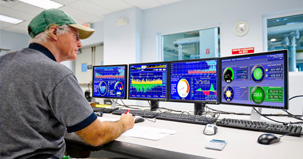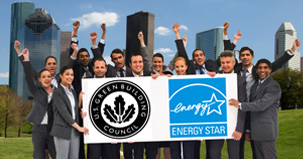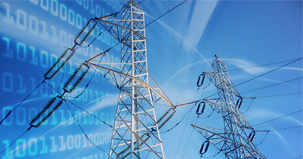- Home
- Smart Data
Smart Data
Actionable intelligence on energy and water use:
- Helps users identify inefficencies, and waste
- Provides real-time feedback on conservation
Right data for the right audience:
- Facility managers identify when and where energy is wasted
- CFO's can track and verify financial savings from initiatives
- Company knows its carbon and water footprint
Related Products
 Information any time, anywhere
Information any time, anywhere - Smart User
Smart User
Smart users leverage real-time data and reduce energy and water use by:
- Continuously identifying opportunities
- Acting on opportunities
- Tracking and verifying savings
- Sustaining savings
Related Products
 Monitor, Manage, Maintain
Monitor, Manage, Maintain - Smart Community
Smart Community
A smart community is one where all stakeholders are engaged in energy and water conservation. A smart community can be achieved by:
- Showing people precisely how much they are using
- Providing real-time feedback on conservation actions
- Effectively communicating efficiency results
Related Products
 Communicate and Conserve
Communicate and Conserve - Smart Grid
Smart Grid
Smart grid, as we define it, is a "green grid", with efficient resource use and the key to a low-carbon future. We help our customers prepare for the smart grid by:
- Engaging users with smart data
- Enabling smart users to increase resource efficiency
- Educating & empowering smart communities
Related Products
 Smart grid and a smarter future
Smart grid and a smarter future - Smart Buildings
Smart Buildings
Smart buildings maximize resource (energy, water, capital) efficiency. These buildings are optimized using energy and water management process with high data visibility which lead to reduced energy and water spending.
- Higher operating income and higher asset values for owners
- Increased productivity for occupants
- Lower carbon footprint for the community
 Resource efficient buildings
Resource efficient buildings
Subtitle!
Recent Posts
Smart Growth: The Only Real Choice
In most suburban communities, where even the current economy isn’t halting construction of retail strip malls, office buildings and business parks, it’s easy to see that when it comes to growth, Americans are addicted to more, bigger, best.
The time has come, however, to add one more adjective to that list: smart. Real, concentrated smart growth initiatives help to mitigate the effects of climate change and go quite a ways in reducing the all-important carbon footprint. As a bonus, smart growth choices will save money and resources.
In reducing carbon emissions, commercial buildings are of primary concern. Currently, with the push to “go green” looming all around, a popular means of making a building more efficient is the installation of alternative energy systems such as photovoltaic (solar) panels.
Buildings all around the world are being designed and retrofitted with PV systems. In fact, currently, over 100 countries have buildings equipped with equipment to capture solar energy. This includes both ground-mounted and building-integrated systems. Wind energy is far less popular in the urban setting, particularly because of the safety risks involved.
The multiplicity of smart growth options available to a new facility is certainly exciting. An important aspect of green building is the use of what the Environmental Protection Agency (EPA) calls “preferable building materials.” These are materials that are the most sustainable for the given building, and will vary from project to project.
Preferable materials can include anything from Forest Standard Certified (FSC) lumber to repurposed stone and metal. If constructing the building involves demolition of an old one, recycling of materials can be done. Industrial materials such as foundry sand, coal combustion products, as well as construction and demolition debris can be reprocessed and made useful to the construction industry. This is because they have many of the same properties as the virgin materials they replace. In fact, it is even possible that this recycling can improve the quality of a product.
Whether building a new facility or retrofitting an old one, the most ambitious of green builders attempt to construct a net-zero building. It’s no easy path to construct a building that gives off zero carbon emissions annually, but this is a rewarding goal.
Though building a net-zero facility can be stressful because you have to put your trust in new technologies as well as cutting edge architects, doing so will put you at the head of the green building pack. Besides making use of photovoltaic systems, net-zero buildings have to operate with extremely efficient utilities. Lighting, heating and air conditioning all have to be accounted for in detail.
This is where energy monitoring systems come into play. Simply put, you don’t know what you don’t know. And, it’s not possible to know if something is going wrong with your mechanical systems unless you monitor them on a regular basis. While it’s all well and good to add alternative energy technologies to your building, it’s equally important to work with what you already have, and ensure that as little waste as possible is occurring.
Noveda Technologies, based in Branchburg, N.J., is one example of a company that offers energy monitoring technology. Whether you use conventional energy sources or a combination of conventional and alterative systems, Noveda’s EnergyFlow Monitor web-based technology provides precise real-time energy monitoring, as well as energy management capabilities. EnergyFlow helps you to optimize your building’s performance, which puts you one step closer to a net-zero facility. The monthly utility savings is a great bonus, as well.
Noveda’s real-time water monitoring platform operates on the same principles as EnergyFlow. With this system, water use is monitored at one-minute intervals. Users can view the water use information and compare it to predefined benchmarks. Real-time leak detection and control are also part of this system, as are leak alerts. Since the most common source of water waste worldwide is leaky pipes, this technology is critical to optimizing building performance – saving energy and money.
In assessing your building’s energy performance, a carbon footprint monitor is also crucial. The Noveda Carbon Footprint Monitor displays the carbon dioxide emitted by your building in metric tons, and shows the acreage of new trees it would take to offset these emissions. If the building uses energy efficient technologies, the carbon footprint monitor also displays the volume of greenhouse gasses and carbon dioxide emissions avoided.
In a world where investors are leery of unsustainable projects, this evidence of efficiency is crucial in establishing and promoting your building’s sustainability. Though you’ve installed efficient energies, you can’t possibly understand the effect they have until you view carbon footprint information before and after the changes.
There are several ways to go about it, but being a part of the “Smart Growth” movement is an increasingly vital consideration. This is true in both corporate and private life. You owe it to yourself, your bottom line and the environment to find out how your company can be a part of this exciting trend.
Originally published in greenbuildingspro.com